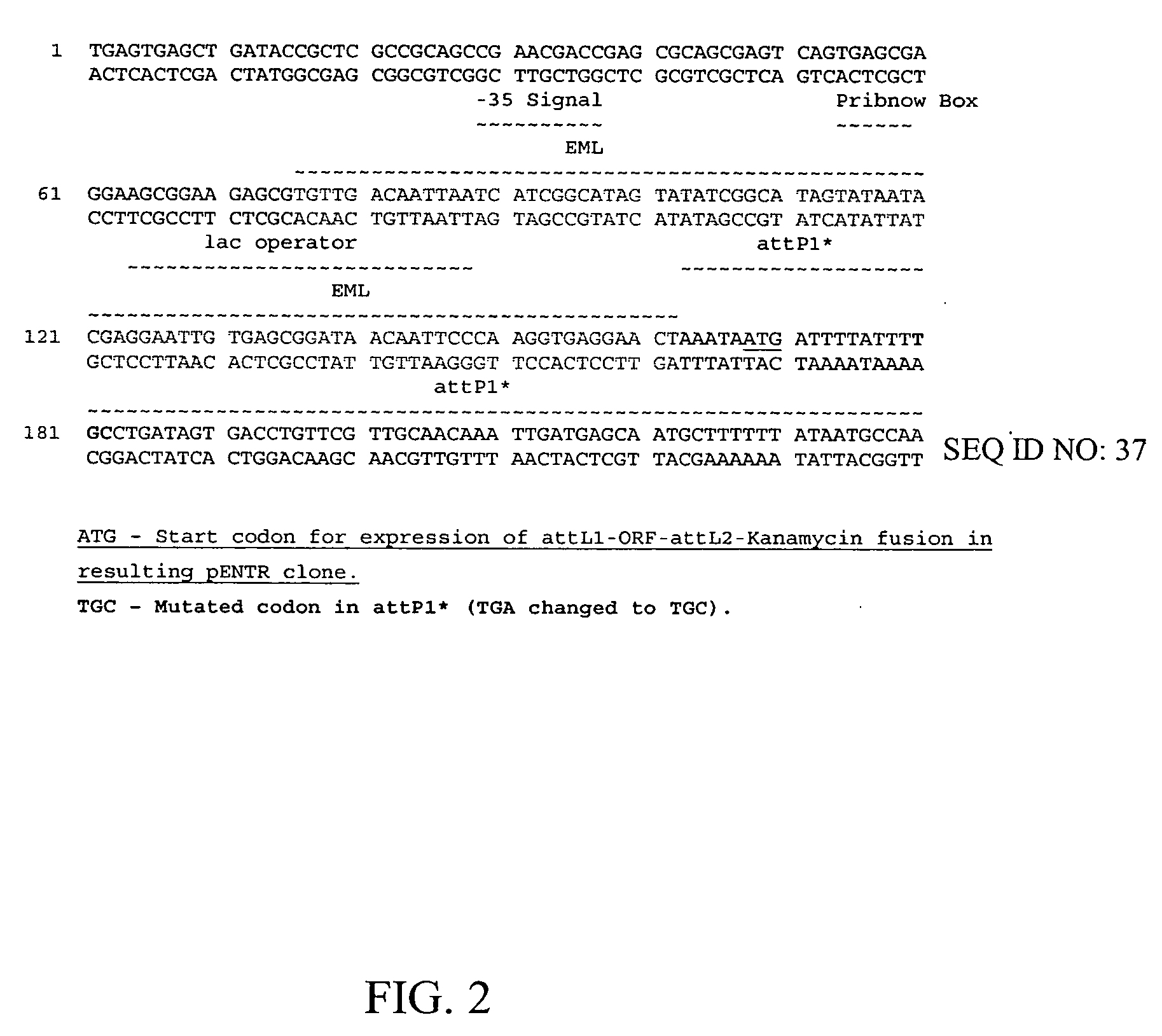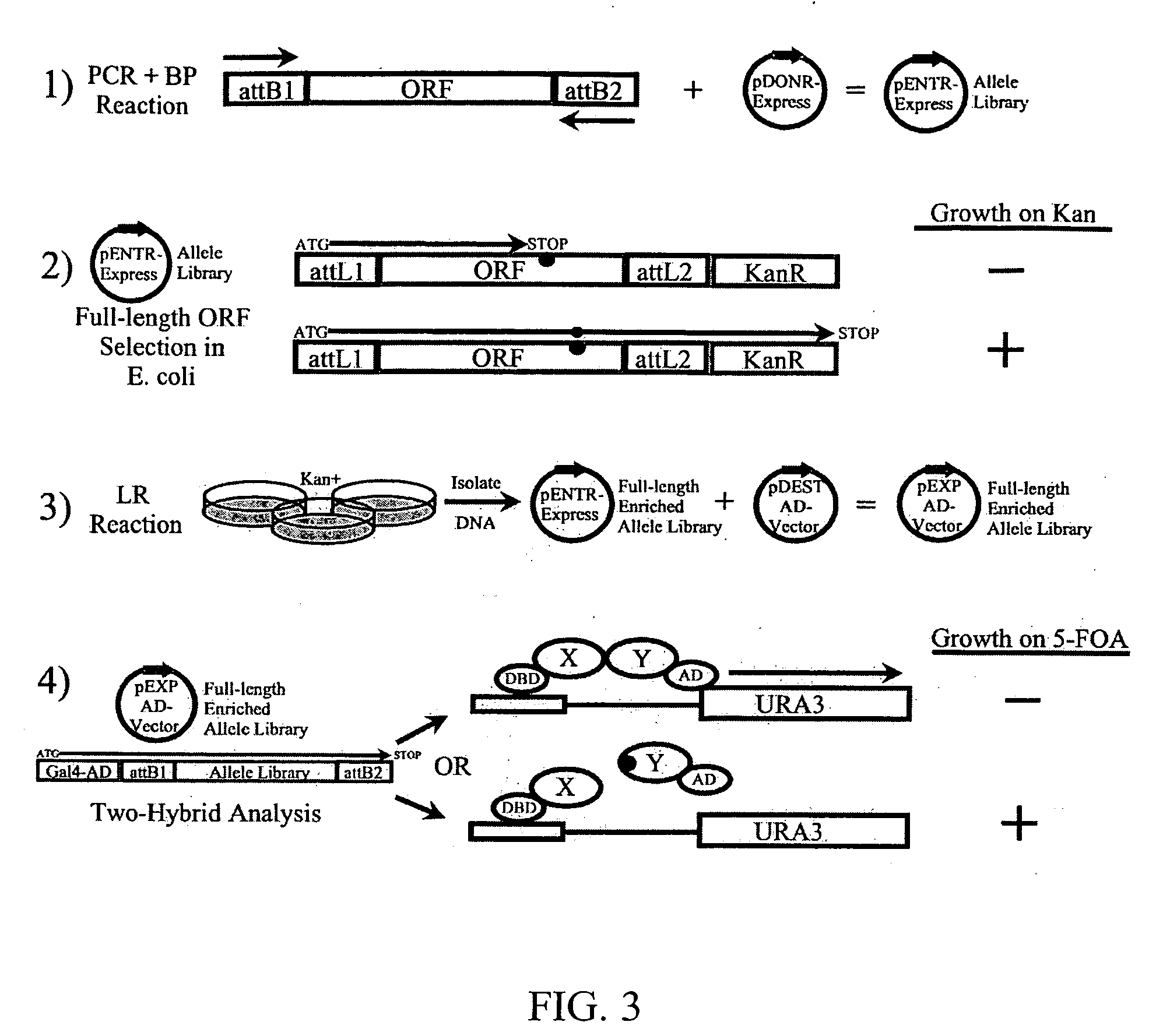Reverse two-hybrid system for identification of interaction domains
a two-hybrid system and interaction domain technology, applied in the field of recombinant dna technology, can solve the problems of toxicity and cell death, assembly limits library complexity, and the method is not practical for screening out truncated proteins from libraries
- Summary
- Abstract
- Description
- Claims
- Application Information
AI Technical Summary
Benefits of technology
Problems solved by technology
Method used
Image
Examples
example 1
DNA Constructs
[0157] The pDONR-Express vector was constructed using pDONR223 (Invitrogen, Carlsbad, Calif.) as the backbone. In order to express ORFs as pENTR clones in the GATEWAY™ cloning system, a promoter was placed upstream of the attP1 site and a single base pair change was made to remove a stop codon located 20 bp downstream of the 5′ end of attP1. This was accomplished by using an overlapping PCR strategy and the restriction enzymes SapI and XmnI. Neomycin phosphotransferase from pLenti3 / V5 DEST (Invitrogen) was PCR amplified to include EcoRV and XbaI sites and cloned downstream and in-frame with attP2. Three promoter systems were evaluated (EM-7, pBAD and LacZ promoters), with EM-7 producing the desired results. However, an inducible promoter system was needed to check the gene of interest for cryptic promoter activity, which will produce false positives by expressing partial ORFs fused to attL2-KanR. Therefore, the lacO was inserted into the EM-7 promoter, producing the I...
example 2
Mutagenic PCR
[0161] The protocol was obtained from the Powers Lab webpage at UC Davis. PCR conditions set up to generate 1 mutation for every 60 bp using the primers attB1-5′ (100 ng), attB2-3′ (100 ng), 5 μl Taq Buffer w / o MgCl2, 15 μl MgCl2 (50 mM), 4 μl MnCl2 (5 mM), 1 μl each of 100 mM dGTP, dCTP and dTTP and 1 μl of 10 mM dATP, 1 μl Platinum rTaq and dH2O to 50 μl. Thirty cycles of PCR were performed at a Tm of 55° C.
example 3
[0162] The MyoD1 allele library was generated via PCR using 100 ng each of the oligos (5′-ACA AGT TTG TAC AAA AAA GCA G-3′) (SEQ ID NO: 31) and (5′-ACC ACT TTG TAC AAG AAA GCT-3′) (SEQ ID NO: 32) and pEXP22 / MyoD1 (10 ng) as the template combined with 45 μl Plantinum PCR Supermix HiFi (Invitrogen, Carlsbad, Calif.) with a TM of 55° C. using standard PCR conditions. The RalGDS RA allele library was generated via PCR using 100 ng each of the oligos (5′-ACA AGT TTG TAC AAA AAA GCA G-3′) (SEQ ID NO: 31) and (5′-ACC ACT TTG TAC AAG AAA GCT-3′) (SEQ ID NO: 32) and pEXP22 / RalGDS (10 ng) as the template combined with 45 μl Plantinum PCR Supermix (Invitrogen, Carlsbad, Calif.) with a TM of 55° C. using standard PCR conditions. PCR products were gel purified using S.N.A.P. (Invitrogen, Carlsbad, Calif.) and quantified by measuring the OD260 value on a spectrophotometer.
PUM
| Property | Measurement | Unit |
|---|---|---|
| Tm | aaaaa | aaaaa |
| TM | aaaaa | aaaaa |
| temperature | aaaaa | aaaaa |
Abstract
Description
Claims
Application Information
 Login to View More
Login to View More - R&D
- Intellectual Property
- Life Sciences
- Materials
- Tech Scout
- Unparalleled Data Quality
- Higher Quality Content
- 60% Fewer Hallucinations
Browse by: Latest US Patents, China's latest patents, Technical Efficacy Thesaurus, Application Domain, Technology Topic, Popular Technical Reports.
© 2025 PatSnap. All rights reserved.Legal|Privacy policy|Modern Slavery Act Transparency Statement|Sitemap|About US| Contact US: help@patsnap.com



